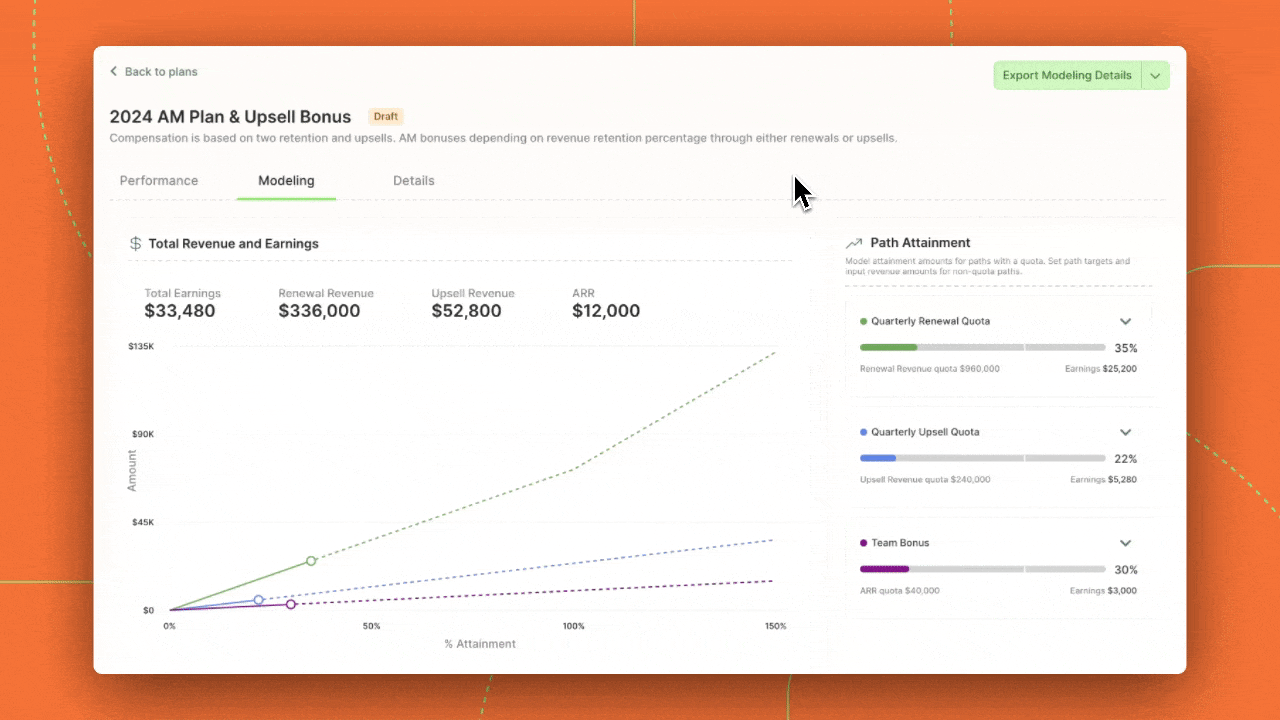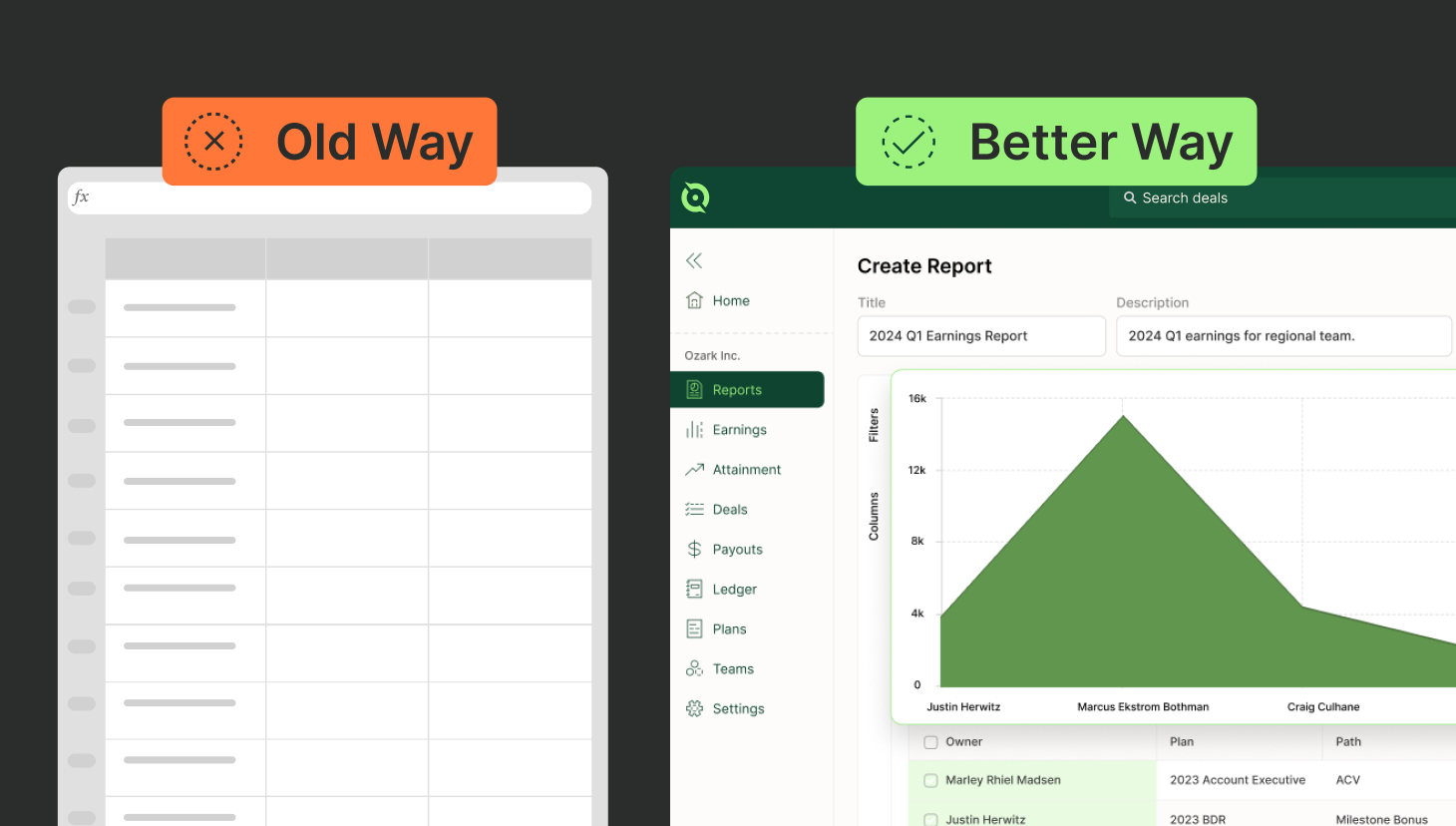SaaS companies rely on recurring revenue sales compensation models to incentivize sales reps toward long-term customer relationships and revenue stability rather than short-term gains.
By rewarding contract renewals, expansions, and customer retention, these models align sales goals with the company’s growth, making them ideal for subscription-based businesses that depend on sustainable revenue streams.
Research shows that a 5% increase in customer retention can boost profits by 25-95%, highlighting why retention is vital for SaaS growth.
However, sales compensation plans must carefully align with recurring revenue goals to drive behaviors that support long-term organizational objectives for these strategies to work.
In this guide, we’ll explore recurring revenue models, compensation structures, commission plans, and optimization strategies.
Let’s dive in.
Create Compensation Plans with confidence
RevOps, sales leaders, and finance teams use our free tool to ensure reps’ on-target earnings and quotas line up with industry standards. Customize plans with accelerators, bonuses, and more, by adjusting 9 variables.
Build a Comp PlanWhat Is Recurring Revenue and Why It Matters
We’ll start with defining recurring revenue.
Recurring revenue is consistent, predictable revenue streams generated from ongoing customer subscriptions or services. By contrast, traditional one-time sales feature nonrecurring payments that may not happen again. This can make future revenue forecasting and business growth more difficult.
That’s why recurring revenue is critical to consistent long-term business growth.
It’s integral to SaaS subscription model businesses, enabling them to attain higher average customer lifetime value, stable cash flow, greater customer retention and loyalty, and more predictable growth.
Understanding Recurring Revenue Sales Compensation
Now that you understand recurring revenue let’s tie it to sales compensation.
What is recurring revenue sales compensation?
Sales commission plans for recurring revenue are based on ongoing, recurring revenue generated from customer subscriptions or contracts. Sales incentives for subscription sales are typically calculated as a percentage of recurring revenue and focus on long-term customer retention and value.
By contrast, traditional businesses that generate one-time, non-recurring sales prioritize closing individual deals and tie compensation to a single product or service’s total sale price or profit.
Key Components of a Recurring Revenue Sales Compensation Plan
You’ll include the following components when designing a sales compensation plan that promotes recurring revenue.
| Base salary vs. commissions | Balancing fixed and variable compensation for reps who manage recurring revenue streams motivates them to focus on activities that drive renewals and upselling. |
| Retention bonuses and incentives | Customer retention compensation rewards reps for retention and renewals. It leverages bonuses tied to customer retention metrics to communicate the importance of retention. Likewise, early renewal bonuses and multi-year contract incentives reinforce this message and motivate reps to push for long-term deals. |
| Upsell and cross-sell compensation | Upsell commission structure drives expansion of existing customer accounts. Depending on the structure of your revenue team, the CSM may be responsible for upselling and cross-selling based on gross revenue retention (GRR). However, if your CSMs hand off these opportunities to AEs, they should be incentivized with a bonus structure tied to these leads. |
How to Approach Your Customer Success Comp Plans
Ceate a compensation plan that is fair, motivating, and aligned with the changing role of the CSM.
Take Me to BlogCommon Recurring Revenue Compensation Models
Next, let’s look at some examples of recurring revenue compensation models.
| Flat-rate commissions | Recurring revenue sales commissions are often single-rate incentives paid slightly lower than new business. Flat-rate commissions offer the simplicity of paying the same commission rate for all recurring revenue. |
| Tiered commissions | Reward higher performance with tiered payouts as the revenue or number of deals increases. Tiered commission models for subscription sales can also be based on the required level of effort involved in renewals based on the complexity of your product or service. Tiered commissions may also apply to renewals of customers demonstrating greater CLV. |
| Clawbacks and chargebacks | To manage customer churn, adjust commission and/or issue a clawback when customers cancel their subscriptions within a given period. This is designed to inspire reps to do everything possible to retain customers. |
Best Practices for Structuring a Recurring Revenue Sales Compensation Plan
Leverage these tips when building sales compensation for recurring revenue models.
- Incorporating customer lifetime value (CLTV): CLTV should influence sales compensation decisions. Key considerations include overall customer lifetime value, upsell potential, and cross-sell opportunities. For instance, incentivize renewals, multi-year renewals, upsells and cross-sells within accounts. Then, reward new business opportunities and deals with ICPs as they will most likely renew.
- Aligning compensation with business goals: Ensuring compensation plans motivate the right sales behavior is crucial to achieving business objectives. When aligning sales compensation with customer success, include incentives like bonuses and commissions in the plan. Then leverage upsell, renewal, and customer success metrics to motivate sellers to focus their activities accordingly.
- Flexible compensation plans for scaling companies: As companies grow, compensation plans should adapt to incorporate appropriate incentives based on responsibilities. For instance, early-stage companies often leave renewals with account managers (AMs) or customer success managers (CSMs) allowing AEs to focus on winning new business. However, companies often shift renewal responsibilities to AEs to maintain a direct relationship with customers as they scale.
Streamline commissions for your RevOps, Finance, and Sales teams
Design, track, and manage variable incentives with QuotaPath. Give your RevOps, finance, and sales teams transparency into sales compensation.
Talk to SalesHow QuotaPath Can Help Optimize Recurring Revenue Sales Compensation
For SaaS businesses, managing recurring revenue requires more than a solid compensation plan; it demands tools that enable ongoing tracking, optimization, and alignment with long-term goals.
QuotaPath is a powerful sales compensation platform tailored for businesses dependent on recurring revenue. Designed to support the unique needs of subscription-based models, QuotaPath offers robust tools that allow businesses to track, analyze, and optimize compensation plans that drive renewals, expansions, and customer retention.
With customizable reporting and predictive modeling, QuotaPath enables companies to measure compensation costs, monitor the effectiveness of compensation plans, and adjust strategies to align with recurring revenue goals.
The platform’s real-time earnings forecasting tool also provides sales teams with up-to-date views of their potential commissions, helping them prioritize high-impact deals in their pipeline and motivating them to move opportunities toward renewal or expansion.

Final Tips for Effective Recurring Revenue Sales Compensation
To optimize sales compensation for subscription-based models, include base salary, commissions, retention bonuses and incentives, and upsell and cross-sell compensation. Incentivize these elements through popular compensation models such as flat-rate commissions, tiered commissions, clawbacks, and chargebacks.
Boost recurring revenue sales compensation plan effectiveness by incorporating CLTV, aligning compensation with organizational objectives, and employing a flexible compensation plan as you scale.
Use clear, transparent communication when sharing recurring revenue sales incentive plans to ensure understanding, alignment, and motivation. This serves to increase plan buy-in, adoption, and effectiveness.
Streamline commissions for your RevOps, Finance, and Sales teams
Design, track, and manage variable incentives with QuotaPath. Give your RevOps, finance, and sales teams transparency into sales compensation.
Talk to SalesClosing Thoughts
Recurring revenue sales compensation is essential for driving desired selling behaviors for long-term growth and retention.
Apply this guide’s best practices and tips to build effective sales compensation for subscription-based models.
Lastly, remember to explore QuotaPath’s solutions for managing and optimizing recurring revenue sales compensation. Schedule time with a team member or start a free trial.




